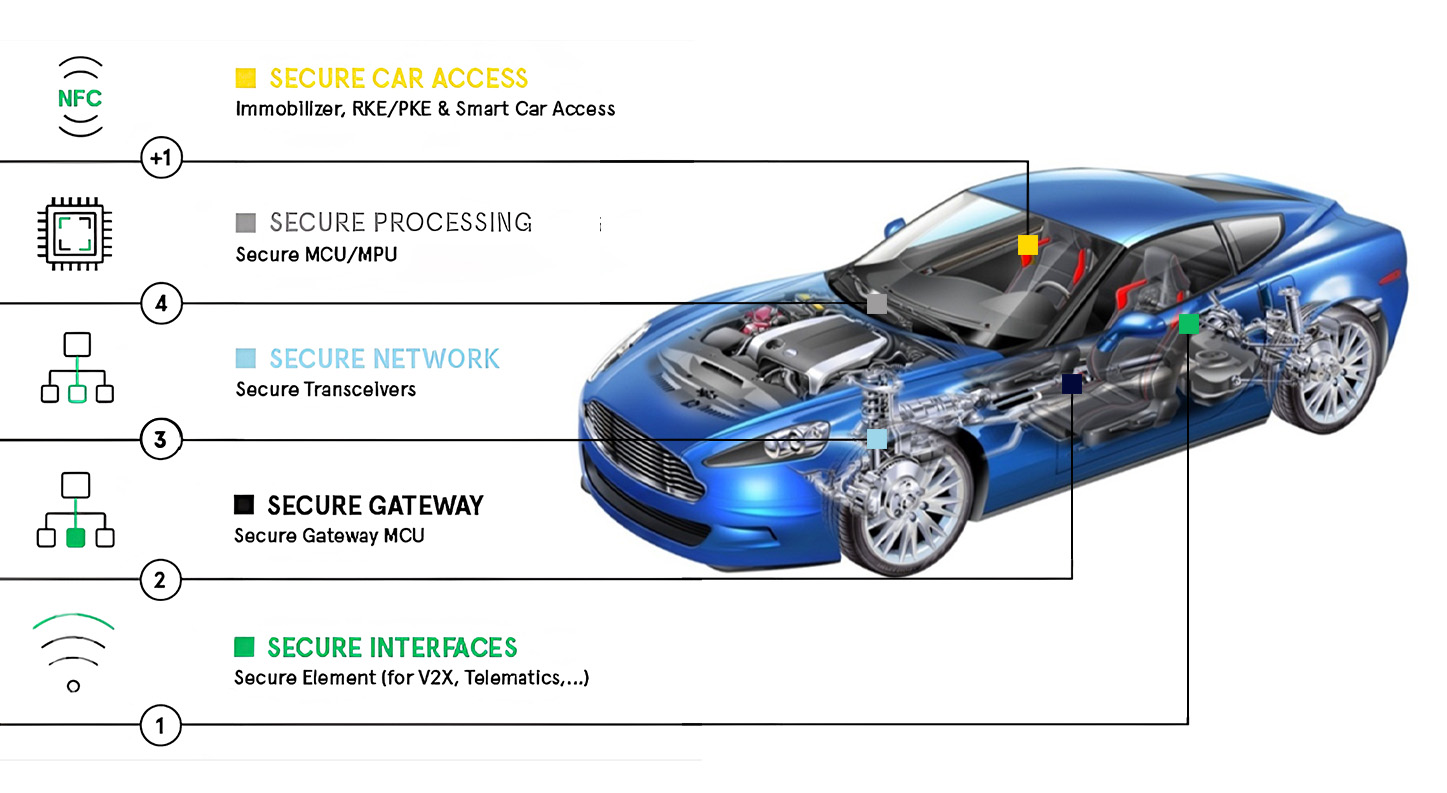Introduction to ADAS:
ADAS full form is Advanced Driver-Assistance Systems are intricate systems that perform various computer vision tasks, such as semantic segmentation, object detection, and image categorization.
Technology-based elements called advanced driver assistance systems are meant to increase vehicle security. Through enhanced indicators and automated systems, these systems improve safety and response times to possible hazards.
Learn More About: PCIe GEN6 Controller IP
While some of these systems can be added later to customize the automobile to the driver, aftermarket features and even whole systems can be integrated into some vehicles as standard equipment.
When embedded electronics in an automobile communicate with one another using the CAN bus, the system may be open to security risks.
Regarding ADAS security, FPGAs can be used to execute system authentication using a hardware root-of-trust or to use encryption for intra-vehicle communication.
Due to its excellent performance and energy economy, FPGA is a viable option for deep learning-based computer vision accelerators.
However, creating a high-performance FPGA accelerator takes a lot of time to compile and necessitates a solid understanding of fundamental hardware principles.
Overlays can solve the issues by utilizing a hardware design and a compiler to accelerate software programs. Nearly all of the common compute layers for learning-based ADAS are present in the overlay architecture.
Additionally, we develop a compiler that can automatically translate high-level neural network descriptions from deep learning frameworks like Caffe and Tensorflow into FPGA programmable instructions, which our overlay architecture can run without reprogramming.
Studies demonstrate that our overlay can process learning tasks in ADAS with less memory utilization and minimal latency.
Historical background and evolution of ADAS

ADAS was first used in the 1970s with the adoption of the anti-lock braking system. Early ADAS include electronic stability control, anti-lock brakes, blind spot information systems, lane departure warning, adaptive cruise control, and traction control.
These systems can be affected by mechanical alignment adjustments or damage from a collision. This has led many manufacturers to require automatic resets for these systems after a mechanical alignment is performed
What is ADAS?
The phrase “advanced driver assistance systems,” or ADAS, refers to the expanding set of safety features intended to increase the safety of drivers, passengers, and pedestrians by lowering the severity and overall frequency of motor vehicle accidents.
To prevent accidents, ADAS can alert drivers to prospective hazards, step in to help the driver maintain control, and, if necessary, lessen the severity of an accident if it is unavoidable.
To a certain extent, ADAS makes up for our errors, including inattention, incorrect control inputs, and outright idiocy.
Humans find it difficult to recognize that we are fallible, but ADAS is available to assist. That is, at least, the concept.
The ADAS umbrella has grown increasingly broad as related ADAS technologies are created and improved. Automakers try to attract customers with a wider variety of features emphasizing convenience and safety.
The word “ADAS” today refers to various passive and active systems provided as options or standards for an increasing number of new cars and commercial vehicles.
These systems are becoming more widespread and comprehensive. Some ADAS features have been so successfully tested and confirmed to work that they are now required in some parts of the world.
Today’s ADAS goes beyond everyday comfort and convenience for drivers and passengers to accident and injury mitigation and prevention.
The boundaries are a little hazy now, and it can often be difficult to tell where the scope of ADAS begins and stops.
What’s the Purpose of ADAS?
Advanced Driver Assistance Technologies (ADAS) are passive and active safety systems created to eliminate human mistakes from driving various automobiles.
ADAS systems use cutting-edge technology to aid drivers while driving and enhance their performance.
ADAS uses various sensor technologies to understand the environment surrounding the car and, if necessary, either inform the driver or take action.

- ADAS system Self driving car while reading a book – Logic Fruit Technologies
ADAS systems are currently used in military, agricultural, construction, and commercial vehicles, as well as cars, trucks, and buses.
The National Highway Traffic Safety Administration reports that more than 36,000 Americans lost their lives in car accidents in 2019 alone. According to the NHTSA’s Traffic Safety Facts Research Note from August 2016, 94% of the collisions resulted from human error or mistakes made by the driver.
Given this fact, it is simple to picture how many lives could be spared if ADAS systems effectively prevented many of these mistakes.
In fact, according to estimates from the IIHS (the Insurance Institute for Highway Safety), even the ADAS technology currently in use might stop or mitigate the impact of 1.8 million accidents annually, potentially sparing up to 10,000 lives.
There are many levels of ADAS, from primary backup cameras and blind-spot warning sensors to lane departure warning systems, adaptive cruise control, self-parking, and more.
Genuinely autonomous vehicles, sometimes known as “self-driving,” which do not require a human driver, will someday be the ultimate extension of ADAS. Although completely driverless vehicles are still years away, ADAS safety measures are already making driving much safer.
Businesses from all around the world are investing billions of dollars in the creation of ADAS technologies. General Motors, Volvo, Toyota, Ford, Volkswagen, Tesla, BMW, and Audi exist. Almost every vehicle manufacturer worldwide is on the lengthy list.
Since ADAS technology is developing quickly, nobody wants to fall behind.
Why is ADAS Important?
The majority of traffic collisions are the result of human mistakes. These cutting-edge safety systems automate and improve several parts of the driving experience to improve safety and safe driving practices.
ADAS has been demonstrated to lower the number of traffic deaths by lowering the possibility of human mistakes.
Those that automate driving, such as automatic emergency braking systems, and those that aid increase drivers’ awareness, like lane departure warning systems, can be divided into two primary types.
These safety systems’ main goal is to make roads safer by generally lowering the number of traffic accidents and minimizing vehicle injuries.
Additionally, they restrict the number of insurance claims resulting from minor mishaps that only cause property damage and no injuries.
The Technological Backbone of ADAS
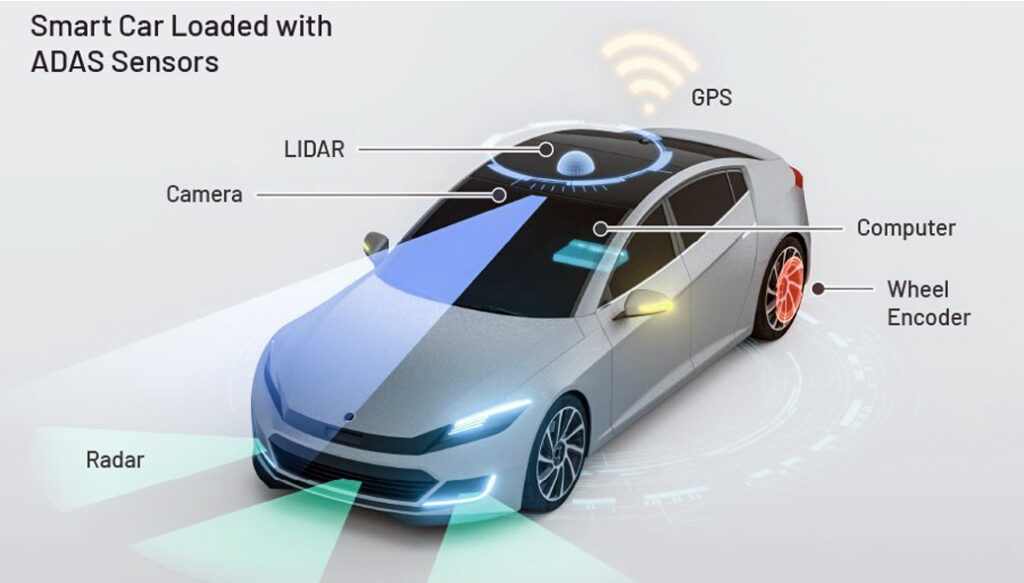
The eyes of ADAS
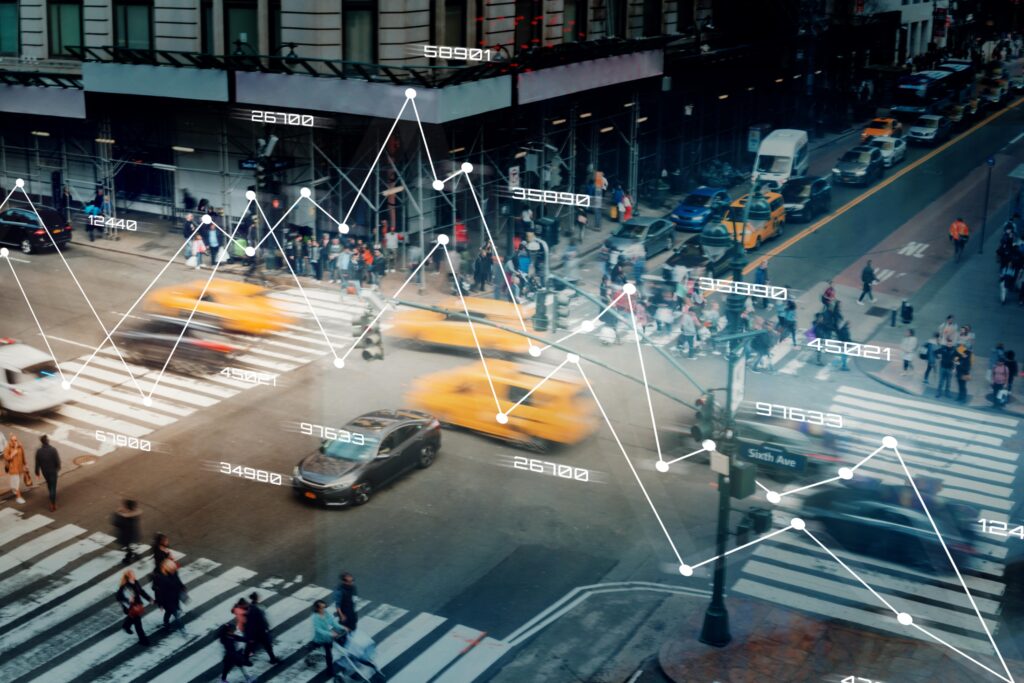
A variety of sensors are used by Advanced Driver Assistance Systems (ADAS) to improve vehicle safety and offer various automated driving functions. These sensors are essential for the car to monitor its environment and be able to make wise decisions.
Four main types of sensors are frequently employed in ADAS:
1) Camera Sensor

The preferred sensor technology among ADAS developers has become a camera-based solutions. Although the technology is still relatively young compared to, say, radar or ultrasonic sensors, it is already capable and adaptable. Their limitations include their sensitivity to degraded performance in poor weather and low or problematic light circumstances.
Cameras are the only sensors in this group that can distinguish between color and contrast information, making them the best choice for taking images of road signs and other road markings.
They also have the resolution to distinguish between objects like walkers, cyclists, and motorcyclists. Cameras are also quite affordable, which makes them particularly appealing to producers of high-volume vehicles.
Due to the limits of the technology, radar data is increasingly being integrated with image sensor data to produce a stream of data that is more dependable and robust under a wider range of environmental circumstances.
- 360-degree and Surround View Cameras

Some modern vehicles come equipped with 360-degree cameras, which display an overhead view of the area around the vehicle by combining several tiny cameras that are mounted on the front, back, and sides of the vehicle. This can be applied to functions like lane change warnings and parking assistance.
For instance, the Limited Trim of the 2022 Hyundai Sonata comes with a Surround View Monitor.
Four cameras are included in this function, two at the back of the car and one on each side mirror. On the infotainment touchscreen, the Sonata offers a unique split-screen image that displays all perspectives.
2) Radar Sensors

In ADAS systems, radar sensors are also frequently utilized, typically as a component of a collision-avoidance system. Radio waves are sent by this kind of ADAS sensor, which reflects off objects and comes back to the sensor.
The distance to an item is determined by the length of time it takes for the wave to return. A computer uses this data to analyze the surrounding region and produce a three-dimensional image.
The ability of radar sensors to detect objects at a distance and in adverse weather situations like rain or fog makes them crucial for ADAS. This ADAS sensor is crucial because the vehicle needs as much data as it can obtain to make the safest decision.
3) Lidar Sensors

Similar to radar, Light Detection and Ranging (Lidar) devices measure distances using lasers. Lidar sensors can also accurately and effectively locate tiny objects. They can, for instance, spot persons and geographical anomalies.
Lidar uses billions of light photons per second to instantly detect non-stationary objects. To find objects nearby, it uses a pulsed laser.
Lidar ADAS sensors are incredibly precise and detailed yet have a large range, with both camera and radar advantages.
4) Ultrasonic/Sonar Sensors

Parking assistance and self-parking systems are the main applications of ultrasonic sensors. The front and/or rear bumper covers include these ADAS sensors, which use reflected high-frequency sound waves to recognize people, other vehicles, and other things nearby.
Sonar sensors may also tell if a car is parked correctly by how it is positioned within the area. This feature will either emit a warning tone or use brake control to relocate the automobile into a more appropriate position if it determines that the vehicle has strayed outside of an acceptable zone.
Air-bag control systems also contain ultrasonic sensors. These function by sending out a brief ultrasonic burst when the car’s airbags deploy. This sensor aids in pinpointing the occupant’s precise location.
5) Human-Machine Interface (HMI):

The interface between the driver and the automated systems in the car is greatly improved by the Human-Machine Interface (HMI) in Advanced Driver Assistance Systems (ADAS). By offering convenience and safety features, ADAS refers to a collection of technologies and systems that are intended to support and enhance the driving experience.
The goal of the HMI in ADAS is to make sure that the driver can quickly comprehend and utilize these technologies while keeping their focus on the road.
Below, we will be exploring the many advantages of human-machine interaction in autonomous vehicles:
- To identify and react to their surroundings, autonomous vehicles (AV) are becoming more and more intelligent, relying on cutting-edge sensors and artificial intelligence (AI).
- To create smarter and safer transportation systems, the car industry is aggressively investigating ADAS technology.
- Autonomous vehicles have the potential to cut down on traffic deaths by up to 80%, according to recent research by the National Highway Traffic Safety Administration (NHTSA).
- For automated driving systems to understand and react to their environment, human-machine interaction (HMI) has become essential. Without it, these systems are ineffective.
- They can accurately detect and manage difficult driving situations, such as inclement weather or intricate traffic systems, with the use of cutting-edge HMI standards.
- Advanced HMI interfaces also enable AVs to identify objects and people and decide on the best course of action, such as slowing down or halting pedestrians.
- Additionally, HMI can lessen driver exhaustion, enabling automated control systems to take over in hazardous driving situations.
- HMI can also provide real-time communication between drivers and other vehicles, enabling a higher degree of awareness among all the moving vehicles on the road.
- Due to their enhanced capacity to perceive and react to their surroundings, individuals can move more swiftly and safely when using HMI protocols.
- In addition, HMI technology can reduce the likelihood of accidents by allowing for earlier, more accurate detection of hazardous circumstances.
- Thus, using HMI protocols can provide many benefits concerning improved safety, efficiency, and performance in autonomous vehicles.
Challenges and Future Scope of Human-Machine Interaction

- Current Challenges:
- Understanding complicated and high-dimensional datasets, identifying and understanding human purpose and context, and creating effective and reliable techniques for natural language processing, dialogue systems, and machine vision are all challenges in the subject of human-machine interaction.
- Future Scope:
- The accuracy and dependability of human-machine interaction are anticipated to rise with the development of machine learning and natural language processing technology.
- Machines will be able to comprehend and recognize human input more correctly as a result of developments in artificial intelligence (AI) and natural language processing techniques, including knowledge graphs, deep learning, and neural networks.
- As a result, it is feasible for people and technology to interact in more meaningful ways.
- Customization:
- It should be possible for human-machine interaction to anticipate user demands and tailor interactions accordingly. The interactions will become more individualized and context-specific as technology develops.
- Accessibility:
- Additional advancements, including voice control, gesture control, and augmented reality, need to be made to make the technology more usable.
- Users might converse with chatbots and virtual assistants naturally thanks to augmented reality (AR).
- Privacy:
- Customer privacy must be protected when more user data is gathered. To retain consumer confidence in machine-human interaction, it is crucial to protect their personal information.
- Security:
- To prevent security breaches, maintaining the highest level of connection security between the devices and the user is essential. Use AI security technologies to safeguard against illicit behavior.
- Contextual Understanding:
- To improve interactions between people and machines, technology should concentrate on helping computers grasp context.
- This involves comprehending fine-grained conversational nuance, identifying objects and activities, and appropriately complying with instructions.
- Knowledge Representation:
- The effective interaction between humans and machines also heavily depends on the machine’s capacity to represent and preserve knowledge.
- Machines will be able to comprehend and respond to human interaction better by creating better data structures for representing knowledge.
Connectivity and Integration in ADAS

5G: Revolutionizing data transfer in ADAS.
Advanced Driver Assistance Systems (ADAS) data transport could be revolutionized by 5G technology thanks to its major gains in speed, reliability, and latency. ADAS is anticipated to be impacted by 5G in the following ways:
- High-Speed Data Transfer: In comparison to earlier cellular network generations, 5G networks offer much faster data transfer speeds. This enables real-time transmission and reception of massive volumes of data via ADAS systems. Better object detection and recognition, for instance, is made possible by the uninterrupted transmission of high-definition video streams from cameras and sensors aboard moving vehicles.
- Low Latency: The latency of 5G networks is intended to be extremely low, frequently in the single-digit millisecond range. For ADAS applications where split-second choices can matter, this ultra-low latency is essential. It makes sure that data from cameras and sensors can be processed and used quickly, enhancing the safety and responsiveness of ADAS features like lane-keeping assistance and automatic emergency braking.
- Reliability: 5G networks are made to have very little packet loss and be very reliable. For ADAS systems, this dependability is essential because any disruption in data transfer could pose a safety risk. With 5G, cars can keep a steady and persistent connection to the network, guaranteeing that vital information is always accessible.
- Edge Computing: Edge computing capabilities are made possible by 5G networks, which allows some data processing to be done closer to the data source, such as on the vehicle itself or at adjacent edge servers. As a result, there is a lesser need to send all data back to a single data center, which lowers latency and bandwidth requirements even further.
- V2X Communication: The communication between vehicles and other objects, or “V2X,” is essential to ADAS and autonomous driving systems. Through the provision of a quick and dependable link between vehicles, infrastructure, and other devices, 5G networks can allow V2X communication more successfully. This makes features like traffic management and cooperative collision avoidance possible.
- Over-the-Air (OTA) Updates: Over-the-air software upgrades for ADAS systems are made more dependable and effective with the help of 5G connectivity. Without the need for a customer to visit a dealership, manufacturers can remotely update a vehicle’s software to increase performance, add new features, or fix security flaws.
- Enhanced Mapping and Navigation: For improved navigation and autonomous driving, 5G can enable more frequent and real-time map updates. Travel can be made safer and more productive by allowing vehicles to receive current information on traffic, road conditions, and potential hazards.
- Data Sharing and Collaboration: Vehicle collaboration and data exchange can be facilitated by 5G networks, providing collective intelligence for safer driving. Vehicles can communicate with one another to better navigate by exchanging information about traffic, accidents, and road conditions.
How Does ADAS Work?
ADAS functions by alerting the driver of risk or even intervening to avert a collision.
Autonomous driving assistance systems (ADAS) enable vehicles to perceive their surroundings, interpret this data fast and correctly in a computer system and then give the driver the appropriate output.
ADAS-equipped vehicles include a variety of cutting-edge sensors that support the human driver’s eyes, ears, and decision-making.
Do you have night vision? Although not very well, RADAR can. Before putting your car in reverse, can you echolocate like a bat or a dolphin to check whether there is a child behind it? But SONAR sensors can, so no.
Can you see everything at once? No, but LiDAR sensors and cameras can. Do you always know your precise latitude and longitude? No, but several satellite constellations that provide global positioning services can send that data and more to your car.

- Different types of ADAS sensors used in today’s autonomous vehicle
Several sensors, interfaces, and a potent computer processor make up the ADAS system architecture, which integrates all the data and makes real-time choices.
The onboard ADAS computers use this data to prioritize and take appropriate action after scanning the area around the vehicle.
They are saving lives by averting accidents. These innovations will enable fully autonomous vehicles.
What are some ADAS Applications?
Shatter-resistant glass, three-point seatbelts, and airbags, among other significant vehicle safety advancements from the past, were passive safety features created to reduce injuries during an accident.
With the aid of embedded vision, ADAS systems today actively increase safety by lowering the frequency of accidents and occupant injuries.
A novel AI function that uses sensor fusion to recognize and process things is integrated into the vehicle’s cameras. With image recognition ADAS software, ultrasonic sensors, lidar, and radar, sensor fusion combine massive volumes of data, like how the human brain processes information.
Physically, this technology can react more quickly than a driver ever could. It can instantly evaluate streaming video, identify what it reveals, and decide how to respond.
Some of the most typical ADAS applications are as follows:
Adaptive Cruise Control:
On the highway, where drivers may find it challenging to check their speed and other vehicles continuously, adaptive cruise control is beneficial. Depending on the behavior of nearby objects, advanced cruise control can automatically accelerate, slow down, and occasionally halt the car.
Glare-Free High Beam and Pixel Light:
High beams and pixels that don’t cause glare employ sensors to adjust to the surrounding environment and darkness without disturbing oncoming vehicles. To prevent briefly blinding other road users, this innovative headlight program detects the lights of other vehicles and guides the vehicle’s lights away.
Adaptive Light Control:
The vehicle’s headlights are adjusted to the ambient lighting with adaptive light control. Depending on the surroundings and darkness around the car, it modifies the headlights’ brightness, rotation, and direction.
Automatic Parking:
Automatic parking warns drivers of hidden spaces so they know when to turn the wheel and stop. Compared to conventional side mirrors, vehicles with rearview cameras have a more incredible view of their surroundings. Some systems may even accomplish parking tasks automatically and without the driver’s assistance by merging the input from several sensors.
Autonomous Valet Parking:
Automated valet parking is a novel technology that controls vehicles in parking lots using car sensor meshing, 5G network connection, and cloud services. The vehicle’s location, where it has to travel, and how to get there safely are all provided via sensors. Until the car is securely parked, all this data is meticulously assessed and used to conduct drive acceleration, braking, and steering.
Navigation System:
Drivers can follow a route while focusing on the road with the assistance of voice prompts and on-screen instructions provided by car navigation systems. Some navigational tools can show precise traffic information and, if necessary, suggest an alternative route to avoid gridlock. Even heads-up displays may be available in advanced systems to lessen driver attention.
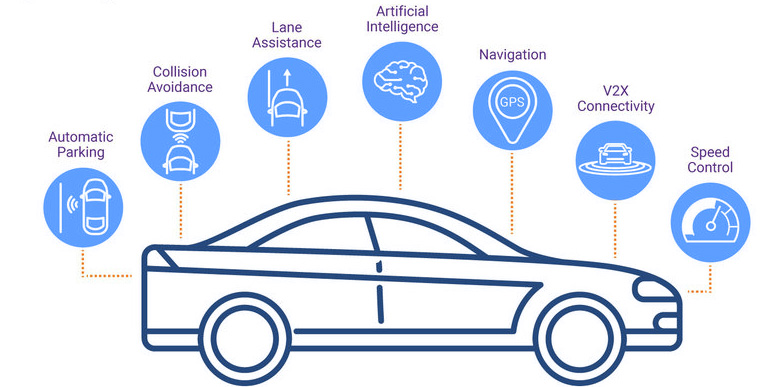
Night Vision:
Drivers can see objects at night that would otherwise be challenging or impossible to view, thanks to night vision devices. Both active and passive night vision systems use thermal energy from moving vehicles, animals, and other objects. Active night vision systems project infrared light.
Unseen Area Monitoring:
Unseen area detection systems use sensors to give drivers access to crucial information that would otherwise be difficult or impossible to gain. Some systems will alert the driver if they attempt to enter an occupied lane or when they identify an object in the driver’s blind spot.
Automatic Emergency Braking:
Sensors are used in automatic emergency braking to determine whether the driver is about to collide with another car or another object on the road. This program can gauge the proximity of oncoming cars and warn the driver of any hazard. Some emergency braking systems can reduce speed, tighten seat belts, and activate adaptive steering to avert a crash.
Crosswind Stabilization:
This ADAS function, which is still relatively new, helps the car combat powerful crosswinds. When a strong wind is blowing across the vehicle while it is moving, the sensors in this system may detect it and apply brakes to the wheels that are being impacted.
Driver Drowsiness Detection:
Drivers are alerted to fatigue or distraction on the road through driver drowsiness detection. There are a few techniques to tell if a motorist is losing concentration. Sensors can examine the driver’s head movement and heart rate to see if they signify tiredness. Other systems send motorist alerts that resemble lane-detecting warning signals.
Driver Monitoring System:
Another tool for assessing the driver’s attentiveness is the driver monitoring system. The video sensors can detect if the driver is drifting or keeping their eyes on the road. Driver warning systems might sound an alarm, vibrate the steering wheel, or use flashlights to warn the driver. Sometimes the car would go to the extreme of entirely stopping the car.
5G and V2X:
With this cutting-edge 5G ADAS capability, commonly referred to as V2X, communication between the vehicle and other vehicles or pedestrians is made more dependable and responsive.
For real-time navigation, millions of automobiles today are linked to cellular networks. By enhancing current techniques and the cellular network, this application will boost situational awareness, control or advise speed reductions to account for traffic congestion, and deliver real-time GPS map updates.
V2X must provide over-the-air software updates for the wide variety of software-driven systems in cars that are currently available, including map updates, bug patches, security upgrades, and other updates.
Advantages & Disadvantages of ADAS include:
Advanced Driver Assistance Systems (ADAS) are a set of cutting-edge technologies integrated into modern vehicles to enhance safety, convenience, and overall driving experience. These systems leverage sensors, cameras, radar, and computational power to assist drivers in various ways, making driving safer and more comfortable.
Here are some key benefits of ADAS:
- Improved Fuel Efficiency
 ADAS technologies are essential for maximizing fuel economy, which saves money and has a smaller negative impact on the environment. By eliminating excessive acceleration and braking, features like adaptive cruise control, which automatically changes the vehicle’s speed based on traffic circumstances, help maintain a steady and effective driving speed.
ADAS technologies are essential for maximizing fuel economy, which saves money and has a smaller negative impact on the environment. By eliminating excessive acceleration and braking, features like adaptive cruise control, which automatically changes the vehicle’s speed based on traffic circumstances, help maintain a steady and effective driving speed.
Additionally, by cutting mileage and maximizing fuel consumption, sophisticated navigation systems and route optimization algorithms can direct drivers to choose the most fuel-efficient routes.
Manufacturers actively support efforts for global sustainability by incorporating ADAS into cars and assisting drivers in reducing their fuel costs.
- Enhanced Traffic Management
 ADAS technologies play a key role in enhancing traffic management and flow. Real-time information on traffic, road conditions, and detours can be provided via intelligent systems like traffic sign recognition and predictive modeling.
ADAS technologies play a key role in enhancing traffic management and flow. Real-time information on traffic, road conditions, and detours can be provided via intelligent systems like traffic sign recognition and predictive modeling.
Drivers can use this information to inform their decisions, steer clear of congested areas, and select alternative routes. All of them shorten commuting times and overall congestion.
Additionally, vehicles can communicate with one another via vehicle-to-vehicle communication systems to convey information about their speed, location, and intended actions, resulting in a smoother and more effective flow of traffic.
The future brings the prospect of less traffic congestion, increased road capacity, and higher transportation effectiveness thanks to ADAS.
- Driver Comfort and Convenience
 ADAS technologies improve driver comfort and convenience, which improves the experience of driving. By adjusting the beam pattern and direction of features like adaptive headlights based on the road’s conditions, drivers may see better and experience less eye fatigue.
ADAS technologies improve driver comfort and convenience, which improves the experience of driving. By adjusting the beam pattern and direction of features like adaptive headlights based on the road’s conditions, drivers may see better and experience less eye fatigue.
Additionally, devices like automatic parking aids remove the tension associated with parking by utilizing sensors and cameras to smoothly steer the vehicle into confined places.
Drivers can operate a variety of car functions, such as temperature control, music controls, and navigation commands, hands-free by utilizing ADAS, which can also combine speech recognition and natural language processing.
ADAS technologies are making driving a more peaceful and seamless experience by putting the driver’s convenience and comfort first.
- Prevention of Human Error
 The capacity of ADAS to avoid accidents and lessen the effects of human error is one of its main advantages. As an extra set of eyes, technologies like forward collision warning, blind spot identification, and automatic emergency braking help drivers avoid potential collisions.
The capacity of ADAS to avoid accidents and lessen the effects of human error is one of its main advantages. As an extra set of eyes, technologies like forward collision warning, blind spot identification, and automatic emergency braking help drivers avoid potential collisions.
Driver behavior is monitored by lane-keeping assistance and driver drowsiness detection systems, which act when necessary to prevent accidents brought on by inattention or exhaustion.
ADAS technologies prevent fatalities, injuries, and property damage by drastically lowering the frequency of collisions and near-collisions.
All users of the road benefit from a safer driving environment as a result of the integration of these devices into automobiles.
- Enhanced Vehicle Connectivity and Integration
 The development of ADAS technologies opens up new possibilities for integration and connectivity in vehicles.
The development of ADAS technologies opens up new possibilities for integration and connectivity in vehicles.
Through functions like smartphone integration, users can wirelessly link their devices to the infotainment system of the car, enabling hands-free calling, music streaming, and the use of navigation ADAS software development.
Smart home systems and ADAS can work together. enabling motorists to operate remote home appliances from their cars.
By enabling a seamless connection between the driver’s digital ecosystem and the car, this integration improves convenience and effectiveness. simplifying and enhancing the efficiency of daily tasks.
- Insurance Benefits and Cost Savings
 For car owners, ADAS technologies can result in significant insurance savings and financial advantages. Due to the demonstrated safety advantages of ADAS technologies, insurance companies may offer lower premiums for vehicles with these features.
For car owners, ADAS technologies can result in significant insurance savings and financial advantages. Due to the demonstrated safety advantages of ADAS technologies, insurance companies may offer lower premiums for vehicles with these features.
The use of ADAS technology, such as forward collision warning and lane-keeping assistance, can lessen the severity of incidents and help prevent accidents altogether. As a result, there are fewer insurance claims, which lowers expenses for both insurance companies and car owners.
Drivers may experience long-term insurance premium reductions while gaining more security and peace of mind by choosing automobiles with ADAS.
- Accessibility and Inclusivity
 In the area of transportation, ADAS technologies help to promote accessibility and inclusivity. Features like automated emergency braking and adaptive cruise control can make it easier for people with impairments or restricted mobility to drive safely and independently.
In the area of transportation, ADAS technologies help to promote accessibility and inclusivity. Features like automated emergency braking and adaptive cruise control can make it easier for people with impairments or restricted mobility to drive safely and independently.
ADAS helps to lessen the difficulties faced by people with diverse abilities, enabling them to travel the roadways with more assurance and independence.
Additionally, voice-activated controls and clear user interfaces make operating a car more accessible for people with vision problems or dexterity restrictions.
Disadvantages of ADAS includes:
Disadvantages of ADAS
1. Risk of over-reliance:
- The possibility that drivers would begin to rely too much on ADAS systems is one of the major worries surrounding this technology. The distinction between considering these technologies as assistance and seeing them as a replacement for focused driving is minor but significant.
- It can lead to complacency when drivers begin to place an undue amount of trust in their ADAS, thinking it will always intervene appropriately. This delusion of security could cause one to pay less attention to the road, which can be dangerous in some circumstances.
2. Economic Implications:
- The cost of the technology underlying ADAS is high. Although it is becoming more widely available, installing these technologies can significantly increase the cost of a car.
- Furthermore, because of their complexity, repairing these systems in the event that they break down or sustain damage can be extremely costly. This implies higher upfront prices for purchasers as well as possibly higher ongoing maintenance expenditures.
3. Technical Limitations and Learning Curve:
- As with every technology, ADAS is not perfect. There are restrictions on these systems. For example, sensors may not perform at their best during periods of intense rain or when covered with snow or muck.
- Drivers may overestimate the system’s capabilities if they are unaware of these flaws, which could result in hazardous situations.
- In addition, there may be differences in the controls and behavior of the system because every car manufacturer has a different perspective on ADAS. This creates a learning curve for new users or drivers changing between cars, which, if left unchecked, might lead to misunderstandings and possible abuse.
4. Interference with Traditional Driving Skills:
- Concerns about ADAS potentially weakening basic driving skills are on the rise, particularly among driving purists and educators.
- When systems take over tasks like parking and keeping a safe distance from other cars, novice drivers may not get the chance to learn these crucial skills during their early driving years.
- People may be at a disadvantage if they grow accustomed to these assistive features over time and suddenly find themselves in a car without them. This is because they may not have the skills or confidence needed to drive safely and successfully.
Role of FPGA and Hardware in ADAS

In ADAS, FPGAs play a significant but frequently underappreciated role. FPGAs are untold heroes in the ADAS ecosystem even if they might not get as much credit as other parts like sensors or microprocessors for several reasons:
- Customizable Hardware Acceleration: FPGAs are extremely programmable and can be tailored to speed up particular algorithms and ADAS-related operations including object detection, tracking, and sensor fusion. With general-purpose CPUs or general-purpose GPUs, it is not always possible to obtain optimum performance.
- Low Latency: Due to their low latency, FPGAs are well-suited for real-time processing in ADAS applications. Because they can interpret data quickly, they can react quickly to shifting traffic conditions, possible hazards, or other vehicles.
- Power Efficiency: Power-efficient FPGAs are essential for automotive applications where reducing power consumption is key. In comparison to conventional CPUs and GPUs, they can handle heavy computations with less power usage.
- Reliable and Robust: FPGAs are renowned for their dependability and toughness. They are particularly suited for automotive conditions, which can be harsh and unpredictable because they are less sensitive to environmental influences including temperature changes and electromagnetic interference.
- Safety-Critical Applications: Safety-critical ADAS features include automated emergency braking and adaptive cruise control. To improve safety and guarantee uninterrupted operation even in the presence of faults or failures, redundant, fail-safe architectures can be employed with FPGAs.
- Rapid Prototyping: ADAS algorithm development and quick prototyping are made possible by FPGAs. FPGAs enable automotive engineers to iterate and test new functions or enhancements more quickly, hence accelerating the time to market for ADAS systems.
Challenges of ADAS

Advanced driver assistance systems (ADAS) are a rapidly developing technology with the potential to make driving safer and more efficient. However, there are several challenges and controversies surrounding ADAS, including:
- Technical challenges: The proper operation of ADAS systems depends on several sensors, programs, and algorithms. These systems may not always perform as planned in real-world scenarios and can be challenging to create and test. For instance, ADAS systems could struggle to operate in dim lighting or bad weather.
- Cost: The development and implementation of ADAS systems is expensive. Because they are frequently only offered on more expensive automobiles, low-income consumers have less access to them.
- Driver overreliance: One of the main issues with ADAS is that it might encourage excessive driver reliance. This can occur when drivers lose focus on the road because they start to think their car can drive itself. In an emergency, this might be very deadly.
- Ethical concerns: Many ethical issues around ADAS, such as who would be held accountable in the event of an accident involving a car with ADAS, are present. Concerns exist around the possibility of ADAS devices being utilized for spying or other non-safety purposes.
Why the Industry is Demanding FPGAs for Advanced Driver-Assistance Systems
Designing ADAS requires flexibility and customization. Here’s why FPGAs, as opposed to ASICs, are increasingly preferred.
Integrating advanced driver assistance systems (ADAS) into nearly all new cars is happening swiftly.
These systems frequently present Tier 1 suppliers and automakers with special computational requirements for which the CPU or GPU may not be well suited.
It is well known that there are disadvantages to using an FPGA. They aren’t the most affordable devices because silicon provides all programmability.
Because all the connection switches slow down signals more than plain wires, they are slower than other devices made on the same manufacturing node. They reportedly used more energy on the same node than other gadgets.
Studies on how to teach a vehicle to learn on its own and subsequently drive on its own have not yet been completed, even though there has been a lot of research on this subject since the 1950s.
There is now a lot of research on self-driving cars under human supervision in controlled environments with ideal road and climatic conditions, but creating a completely autonomous vehicle presents several difficulties.
Before autonomous vehicles may be used on our roads, there are still several major obstacles that must be removed.
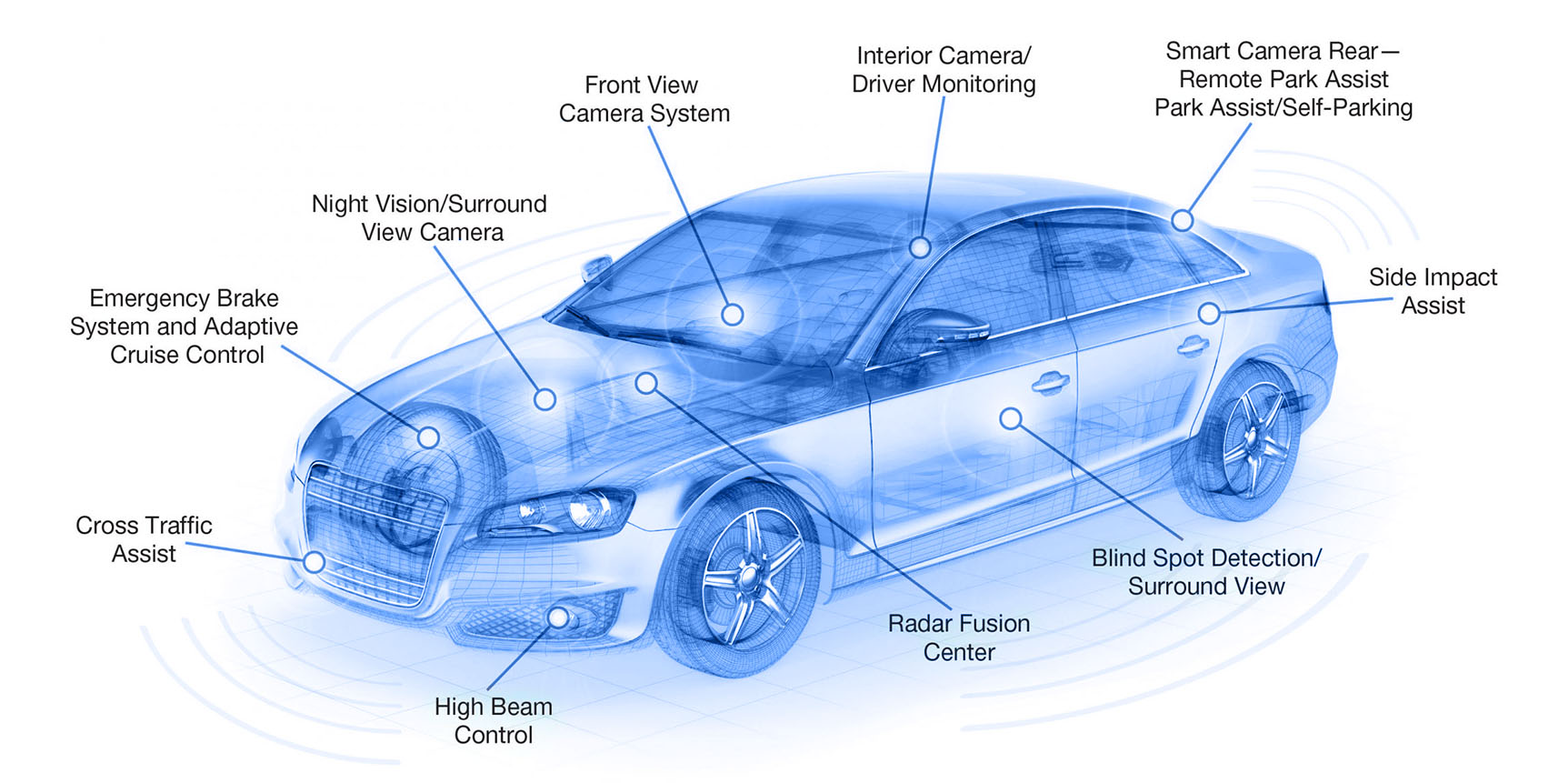
Constraints Unique to Automotive Design
Due to its complex settings and complicated limitations, designing using FPGAs in a mission-critical automotive design differs from designing in other environments.
FPGAs in ADAS are primarily concerned with reliability. In the past, high temperatures have caused problems with packing, assembly, environmental overstress, and ESD, all of which are causes of FPGA failure.
Due to the high operating temperatures in automobiles, this is a crucial design factor for employing FPGAs in ADAS.
As a result, numerous providers have developed FPGA topologies that can function in challenging circumstances.

- Layers of automotive security – ADAS
The Future of ADAS
To solve the convergence of conflicting aims, the growing amount of vehicle electronic hardware and software necessitates considerable modifications in the current automobile design process:
- Improved dependability
- Lower expenses
- Reduced development cycle length
Distributed ADAS electronic controller units (ECUs) are becoming less common in favor of a more integrated ADAS domain controller with centralized ECUs.
This indicates that we currently operate at Level 2, or “Partial Driving Automation,” as SAE International defines.
A vehicle can control steering, accelerating, and decelerating at this level. Still, it is not fully autonomous because a human driver is always present and able to take over at any time.
Conclusion:
Logic Fruit Technologies creates FPGA technology for a variety of applications, including communications, computing, avionics, security, automotive, and consumer electronics, among others. We specialize in real-time FPGA software heterogeneous systems with great performance.
Advanced driver assistance systems have gone from being scarcely available to being included in the majority of newly released vehicles in just a few short years. Automotive industry analysts predict that ADAS will be the next major way for businesses to stand out in such a crowded market. Perhaps ADAS will improve to the point where self-driving cars become the norm in the future.
The most effective form of development taking place right now is ADAS. Of course, electric and hybrid vehicle innovations are ongoing, and both are crucial for lowering greenhouse gas emissions and the usage of fossil fuels.
The most crucial part of travel is human safety, which ADAS directly addresses. Every development in ADAS has an evident and definitive impact on preventing injuries and deaths because more than 90% of traffic accidents, injuries, and fatalities result from human mistakes.
Frequently Asked Questions:
Q: What is an example of ADAS?
A number of ADAS applications, such as automated emergency braking, pedestrian identification, surround view, parking assistance, driver fatigue detection, and gaze detection, help drivers with safety-critical functions to prevent auto accidents and save lives.
Q: What is ADAS image processing?
To assist drivers in having a safe and enjoyable driving experience, Advanced Driver Assistance Systems (ADAS) rely on software, hardware, and firmware solutions built on technologies like RADAR, LIDAR, vision and image processing, or AI.
Q: What are the technologies in ADAS?
Several ADAS applications, such as automated emergency braking, pedestrian identification, surround view, parking assistance, driver fatigue detection, and gaze detection, help drivers with safety-critical functions to prevent auto accidents and save lives.
Q: What is the structure of the ADAS system?
A collection of sensors, interfaces, and a potent CPU comprise the architecture of the ADAS system, which combines all the data and makes judgments instantly.
Q: Is ADAS an embedded system?
Several embedded systems-controlled sensors, cameras, radar, and lidar imaging technologies that are integrated into the vehicle are used by ADAS. Together, these devices collect data in real-time about the environment around the car and the driving behavior of the driver.
Q: How does ADAS work in cars?
The term “ADAS,” or advanced driver assistance system, describes a group of functions intended to increase driving comfort and safety. So how does automotive ADAS operate? ADAS technology monitors the area surrounding a car using a variety of technologies, including radar, cameras, and sensors.





